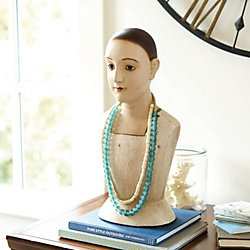Hello! I hope you are having a lovely day! TGIF is how I feel today!! Looking forward to the weekend, weather is supposed to be pretty nice, so I am planing on doing some yard work!
I shared my Santos Doll the other day, if you missed it you can read about it here a few people showed some interest in Santos Dolls and asked me some questions. I love the santos dolls, but I am not an expert on them, so I did some research and you can read below what I found at http://www.santoscagedoll.com/pages/history-of-santos-dolls
A sweet reader, all the way from Italy, asked me where she could purchase one, I guess the best place is online.
A sweet reader, all the way from Italy, asked me where she could purchase one, I guess the best place is online.
History of Santos Dolls
European Beginnings
The Santos dolls take their name from the Spanish word for Saint, and are also known as Santons (French) and Santibelli (Italian). The Santos that started the genre of dolls we currently represent (primarily Spanish Colonial and Western European style), were originally started as copies of 17th century carvings by priests. Originally, Santos were created for use as in-home altars. They were needed in small villages that did not have a priest, as well as for when it was not possible to travel to church, such as during times of war. Their development flourished in Europe in the 1700's and 1800's, primarily due to these wars.
Santos dolls are closely related to the Crèche figures, which were implemented in Italy by St Francis of Assisi, during the 13th century. However, the Crèche are primarily associated with Italian and French nativity and crib scenes. Crèche scenes are still elaborately displayed throughout Italy and in parts of France, most notably in Provence.
Discovery of the New World
European Santos dolls were also brought to the Latin Americas during the Colonial age of Spain's settling of The New World. The dolls were used to aid in the of conversion of the Native Americans and Central American Indians to Catholicism. Many of these original dolls, along with the art that inspired them, were destroyed while trying to settle the West. Therefore, antiques in good shape are rare and very expensive. It is not uncommon to see an antique Santos bring 4 and 5 digit figures. In more recent years, fine and folk art has emerged to replace these dolls. Santos dolls are designed and created by "Santeros" or "Santonniers" (loosely 'saint maker'). As the art form has progressed, the Santos has become recognized as a true artistic doll. Some dolls are rustic carvings, while others have magnificent details.
Reproductions
Santos, particularly the females, exhibit a most loving expression that is also complex and thoughtful. Their shape is often rustic in nature, yet with delicate details. They are sometimes painted in rich colors with detailed eyes. Antique dolls frequently have glass eyes, while reproductions (as well as some antique Santos) most commonly have painted eyes. The dolls emulate the image of Christ, The Virgin Mary, Patron Saints, as well as other notable figures in biblical history.
Here are some images of beautiful ones from the same website http://www.santoscagedoll.com
I love the ones with wings!
This one I absolutely love and it is for sale at http://www.ballarddesigns.com hint, hint, honey... birthday present???
This one is also from http://www.ballarddesigns.com
I hope you enjoyed learning the history of this fascinating dolls. Thanks for stopping by and have a wonderful weekend!
























Cristina!!!! Thanks for this post!
ReplyDeleteHave a nice Saturday!
Un beso
I wasn't familiar with Santos dolls, but they are beautiful! Thanks for the introduction to something new!
ReplyDeleteYou are very welcome Amy!
DeleteOh, I've seen these Santos dolls before, and I love the ones with wings too! Thank you for the history on them, it was interesting to read about.
ReplyDeleteWe would love it if you could visit us and follow, and I would certainly come back and follow you as well. I think my favorite Santos doll on here is the one with head band, sooooo pretty.
~Sheri